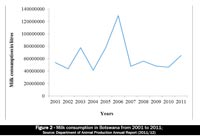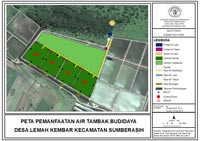|
Research Title /
Graphical Abstract
|
Article Information /
Abstract
|
Download
|
|
Effect of climate change on dairy production in Botswana and its suitable mitigation strategies


|
Original Research, C43
pii: S222877011300043-3
Moreki J.C. and Tsopito C.M.
Online J. Anim. Feed Res., 3(6): 216-221, 2013.
ABSTRACT: This paper paper explores the effects of climate change on dairy production in Botswana. Strategies to reduce the effect of climate change on dairy production are suggested. Dairy farming has not experienced growth over time rendering the country heavily dependent on milk imports. National dairy herd is estimated to be approximately 5000 and per capita consumption of milk about 32.5 litres per person per year. Currently, Botswana is experiencing average high temperatures and low rainfall, frequent droughts and scarcity of both ground and surface water, which all contribute to low livestock and crop productivity. Changes in rainfall patterns, frequent droughts, high incidences of animal diseases (e.g., mastitis and FMD) and parasites, and high environmental temperatures cause significant decrease in livestock productivity. For dairy animals, there is a decline in milk yield and reduced animal weight gain due mainly to high temperatures and inadequate feeds. Mitigation strategies comprise using smaller dairy breeds such as Jersey and Brown Swiss and local Tswana breed, growing fodder crops and utilization of crop residues and constructing cow sheds
Key words: Botswana, Climate Change, Dairy Production, Greenhouse Gases, Mitigation Strategies
|


|
|
Optimization of Whiteleg Shrimp intensive ponds production with dynamic system approach of lemah Kembar village probolinggo East Java


|
Original Research, C44
pii: S222877011300044-3
Suciyono, Andayani S., Mahmudi M.
Online J. Anim. Feed Res., 3(6): 222-229, 2013.
ABSTRACT: The aims of this research was to assess the activities of that occur in ponds culture production intensive vanname shrimp in Lemah Kembar village, Sumberasih, Probolinggo regency, is based of production aspects. In this research, shrimp production was 4182.9 kg/plot, with a cultivation period of 98 days, the amount of 5621.5 kg of feed, with the results of analysis of aquaculture production as follows: Feed convention rate 1.34, Survival rate 75%, Specific growth rate 0,22 gram/days, Final weight 19.23 grams/individuals and 68% Feeding efficiency. The current research conducted a review on the process of intensive shrimp aquaculture production for 98 days, with a stocking density 102 individuals/m3 and evaluation of aquaculture production that occurs in the field. Based on optimization model which is applied, there are two options, the first is by partially harvest 45% (PR 2) so the harvest crop reached 4165.4 kg, total feed 5148 kg, FCR 1.24 with dissolved oxygen 0.4 ppm in the early days and 0.7 ppm in the end of the production. Second option is using non-partial model, harvest crop is 4,456 kg, total feed 5,862 kg, FCR was 1.21. It showed that the optimization model can increase production and significantly decrease FCR.
Key words: Pond Aquaculture, Whiteleg Shrimp, Optimazion Models
|


|
|
Effects of native and microbial phytase on laying performance, shell ash and phosphorus content of hens fed mash and pelleted diets

|
Original Research, C45
pii: S222877011300045-3
Ademola S.G., Lawal T.E., Odu O., Shittu M.D., Oladiran H.O. and Adeshina M.T. 2013.
Online J. Anim. Feed Res., 3(6): 230-234, 2013.
ABSTRACT: The study investigated effects of microbial phytase and native wheat bran phytase on laying performance, egg quality and shell phosphorus of hens fed two forms of diets. Five experimental diets were formulated for the study. Control and basal diets contained similar levels of nutrients. However, basal diet (T1) containing 15% wheat bran (WB) had lower available phosphorus (AVP). Diet forms (mash and pelleted) and microbial phytase supplementation (0 and 900 phytase unit (FYT) were arranged to examine their interaction effects. The 0 FYT microbial phytase represented the native wheat bran phytase activity in the mash diet only. T1 and T2 were mash and pelleted unsupplemented diets respectively. Diets in T3 and T4 were microbial phytase supplemented in mash and pelleted forms respectively. Laying hens fed unsupplemented mash basal diet (T1) had the highest hen day production (HDP) (P<0.024), and the best feed conversion (P<0.012). However, those fed mash supplemented diet (T3) had the lowest HDP and worst feed conversion. Microbial phytase supplementation to mash diet (T3) resulted in lowest egg mass of 45.35 gram daily (P<0.025). Pelleting the unsupplemented diet (T2) yielded poorer feed conversion than those fed unsuplemented mash diet (T1). Hens fed pelleted supplemented diet (T4) had slightly reduced HDP and significantly lower egg mass when compared to the control group. These hens had significantly highest yolk index (P<0.036) and egg shell with the most concentrated phosphorus content (P<0.002). It is concluded that native wheat bran phytase in mash diet containing 15% WB was effective for improved laying performance.
Key words: Hen Day Production, Microbial, Native Phytase Wheat Bran
|


|
|
Growth Performance evaluation of juveniles of Archachatina marginata ovum and Archachatina marginata saturalis snail subspecies fed forages and their nutrient composition in cross river rainforest zone, Nigeria


|
Original Research, C46
pii: S222877011300046-3
Ubua, J. A., Agiang, E. A., Ozung, P. O. and Ebegbulem, V. N.
Online J. Anim. Feed Res., 3(6): 235-239, 2013.
ABSTRACT: The growth performance characteristics of juveniles of Archachatina marginata ovum and Archachatina marginata saturalis snail subspecies were evaluated using a feeding regime of forages. The forages of choice utilized were: Sweet potato (T1), Cocoyam (T2), Banana (T3), pawpaw (T4) and Okra (T5) respectively. The nutrient composition of these forages was equally determined. Results from this study revealed that juveniles of Archachatina marginata ovum recorded better feed intake than those of Archachatina marginata saturalis. The weight gain showed significant difference (P<0.05) between juveniles of the two subspecies. Results of the feed conversion ratio (FCR) were also significantly different (P<0.05) between the subspecies. Treatment 1 (Sweet potato leaves) recorded overall best result in terms of performance compared to other forages used in this study. Results of proximate composition of forages showed that Dry matter (DM), Crude protein (CP), Crude fibre (CF), Ether Extract (EE), Nitrogen Free Extract (NFE) and Ash ranged from 75.16 - 79.62%, 10.88 - 12.76%, 14.45 - 19.68%, 16.82 – 69.00%, 31.10 - 32.63% and12.63 - 17.94% respectively. Okra leaves had the highest Dry matter and Ash contents which were significantly different (P<0.05) from other forages. Sweet potato leaves recorded the least Dry matter and Ash contents and the highest Crude protein content while Okra leaves had the least. However, values of CP in sweet potato leaves were significantly different (P<0.05) from Cocoyam and Okra leaves. The EE content in all the forages were relatively low but sweet potato recorded the highest and Okra the least. There was no significant difference (P>0.05) in Ether extract among the forages. Result of CF showed relative increase across the five forages. Banana leaves had the highest value and was significantly different (P<0.05) from those of sweet Potato and pawpaw leaves. The highest NFE content was recorded in sweet potato leaves. There was significant difference (P<0.05) in the Ash content among all the forages except sweet potato. Results from this study were within the normal proximate values of these forages and confirmed that these leaves (plant protein sources) are good forages for farm animals especially micro-livestock like snails and can enhanced optimum growth characteristics.
Key words: Growth Performance, Juvenile Snails, Nutrient, Composition, Forages
|


|
|
|
|
|
|
|
|
|
|
|
|
|
|
|
|
|
|
|

